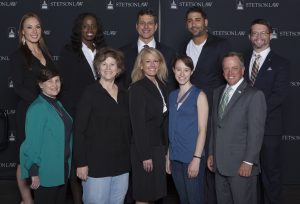Stetson students, alumni win clemency for their clients
Ten students at Stetson University College of Law in Gulfport, Florida, participated in a class designed to assist the 2014 Clemency Project. One of the 1300 clemency grants out of a total of 16,000 petitions was prepared by Stetson Law students in the class.

Professor Podgor’s Clemency Class: – Top row from left to right – Allyson Holca, Starcee Brown, Dan Diaco, Daniel Chehouri, Robert Glenn; Bottom row from left to right – Professor Ellen S. Podgor, Federal Defender Donna Elm, Jennifer Wilson, Juliann Welch and Dean Christopher M. Pietruszkiewicz. Other members of the class not included in this picture here are: Nathan Bruemmer, Victor Meza, and Monica Strady.
“The very fact that you, as a student, may be one of the last remaining hopes for an individual to have his life sentence reduced is an incredible burden, however, it is an honor to be given that responsibility,” student Victor Meza J.D. ’16 said after completing the class. “It was by far the most practical course I had at Stetson Law.”
Stetson’s Gary R. Trombley Family White-Collar Crime Research Professor Ellen S. Podgor and Federal Defender Donna Elm created the class in the fall of 2015.
Jennifer Wilson J.D./LL.M. in Advocacy ’16, was a student in Stetson’s part-time law program who worked with the legislature before heading to law school. She said that taking the class taught her firsthand how the legislative changes in federal sentencing guidelines impacted people and revealed the realities of disparate treatment in sentencing policies.
“It’s a unique kind of advocacy,” said Wilson. “You’re arguing fairness, and trying to convince a decision-maker that the law is different today, sentencing guidelines have changed, and that should be considered.”
In addition to receiving a crash course in clemency and learning how to write drafts of petitions, the Stetson students had an opportunity to work in-depth on cases with Elm, the lead federal public defender for the Middle District of Florida.
“I really learned the client’s story,” said Wilson. “Telling the story more effectively was just as important as knowing the law.”
Students learned how federal sentences are given as well as techniques used to revisit sentences.
“Following the class, students assisted other attorneys and the federal defender’s office with petitions, and some of these clemency petitions were granted by former President Obama,” said Professor Podgor.
After the class concluded, student Juliann Welch worked on a petition that was granted.
Practicing plastic surgeon Dr. Daniel Diaco J.D. ’16 said that he realized that he had a unique skillset after completing the class. He drafted two clemency grants after taking the class, one for a man sentenced to life in prison and one for a person sentenced to 20 years.
“For 25 years, I’ve saved lives as a doctor, but I never saved a life with a pen,” said Diaco, who had the opportunity to call one of the clients in person to share the good news. “I never dreamed I would be able to save a life this way and get so much gratification.”
Several Stetson Law alumni also had successful clemency cases, including Brandon Breslow J.D. ’16, Theresa N. Jean-Pierre Coy J.D. ’04, Dominique Heller J.D. ’07 whose firm had three successful clemency cases, Adam LaBonte J.D. ’13, Brian Tannebaum J.D. ’94, Katherine Earle Yanes J.D. ’97 who received more than 44 clemency grants, and Rachel May Zysk J.D. ’04.
The 2014 Clemency Project was created in light of former President Barack Obama’s initiative to review the sentences of federal prisoners who were given lengthy sentences for non-violent offenses. The criteria for clemency included prisoners who had served 10 years or more in prison, were convicted of non-violent crimes, and if sentenced today, their sentences would be substantially lower.
Post date: Jan. 25, 2017
Media contact: Kate Bradshaw
[email protected] | 727-430-1580